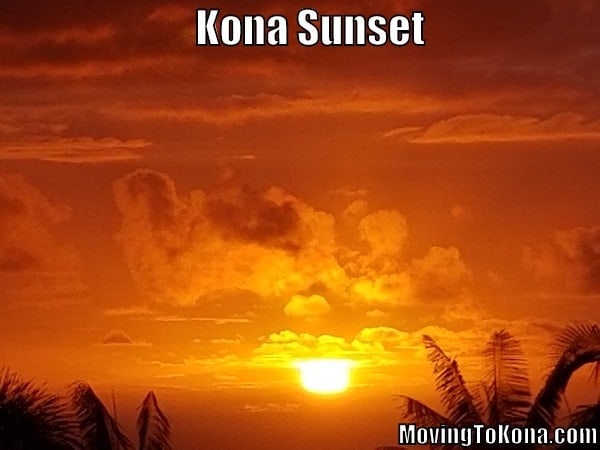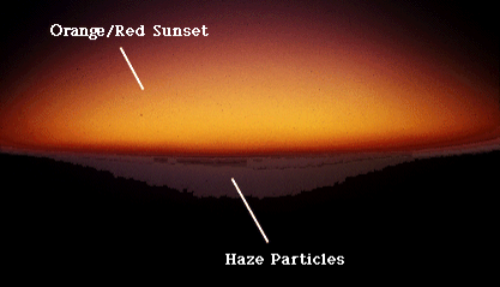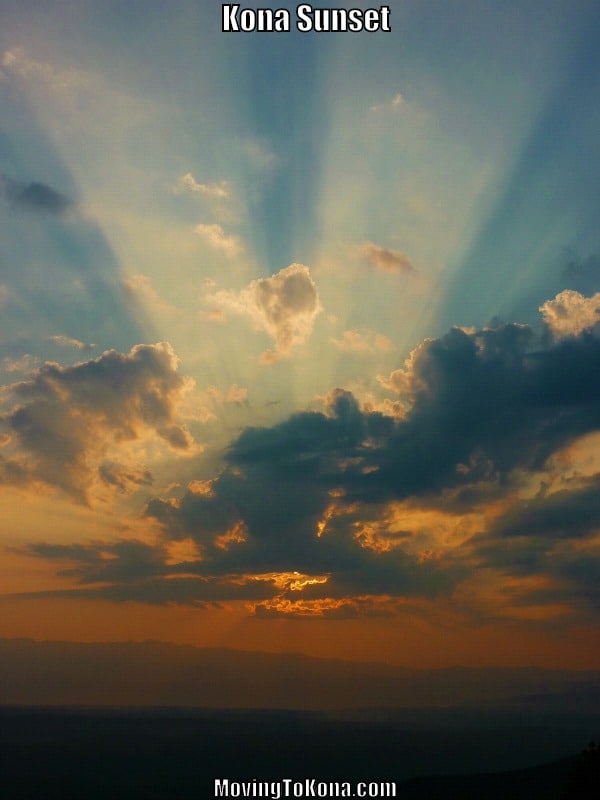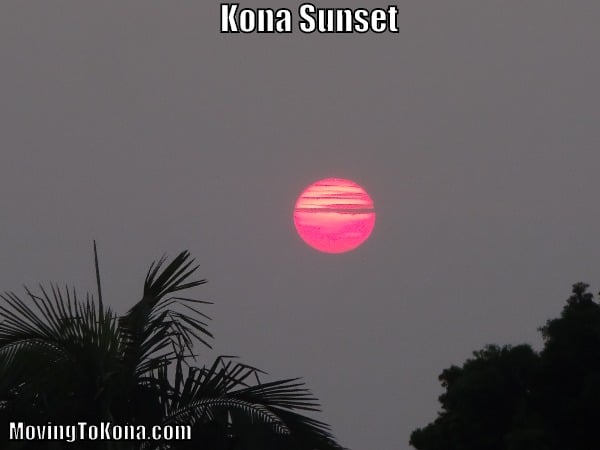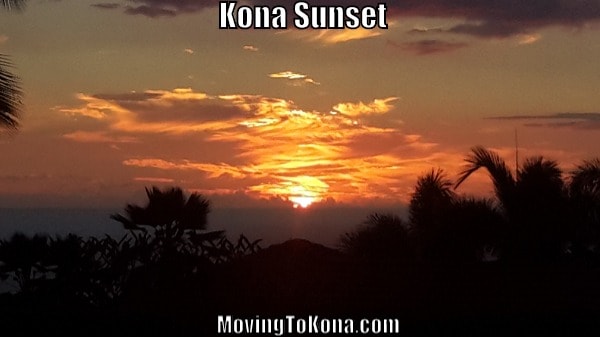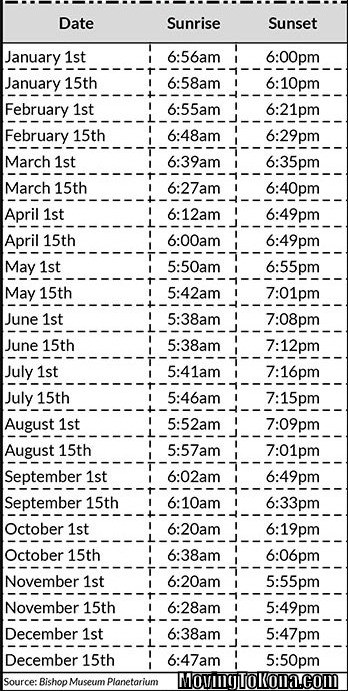Are Kona Sunsets Better? Don’t Kona sunsets seem more vivid, more interesting, and more colorful than in other parts of the world? Just what causes the orange and red sunsets on the Big Island to be so vibrant?
Vog Causes Great Sunsets: Note the sunsets on the Big Island are ‘enhanced’ when our Kīlauea Volcano is spewing vog (more on that in a sec…). Below is a ‘vog-induced’ sunset.
Here are a few sunsets via Kona…
Just What Causes Orange (or Red) Sunsets? Molecules and small particles in the atmosphere change the direction of light rays, causing them to scatter. This scattering affects the color of light coming from the sky, but the details are determined by the wavelength of the light and the size of the particle.
During the day, when the sun is directly overhead, light travels only a short distance through a relatively ‘thinner’ section of the atmosphere. But as the sun edges toward the horizon, the light must travel increasingly longer paths (‘thicker’) and is scattered by more air molecules. By the time it reaches the end of this journey (our eyes), “most of the blue has been scattered out of that beam” explains Stephen Corfidi, a meteorologist at the National Oceanic & Atmospheric Administration (NOAA). What remains are the warmer hues of yellow, orange and red, which blend into a yellowish-orange sunset.
The ‘thicker’ atmosphere, at sunset, acts as a prism to sort out the various wavelengths of sunlight.
The short-wavelength blue and violet are scattered by molecules in the air much more than other colors of the spectrum. This is why blue and violet light reaches our eyes from all directions on a clear day. But because we can’t see violet very well, the sky appears blue.
Scattering also explains the colors of the sunrise and sunset. When the sun is low on the horizon, sunlight passes through more air at sunset and sunrise than during the day, when the sun is higher in the sky. More atmosphere means more molecules to scatter the violet and blue light away from your eyes. If the path is long enough, all of the blue and violet light scatters out of your line of sight. The other colors continue on their way to your eyes. As incoming sunlight passes through a more dense atmosphere, shorter wavelengths of light (violet and blue) are efficiently scattered away by particles suspended in the atmosphere. This allows predominantly yellow and red wavelengths of light to reach the observer’s eyes, producing a yellowish-red sunset.
Why Are Some Sunsets Red? To get a red sky, you need aerosols, explains A. R. Ravishankara, director of chemical sciences at the NOAA Earth System Research Laboratory in Boulder, Colo. Aerosols are solid or liquid particles suspended in the air that originate from both natural processes and human activity.
Natural aerosols come from forest fires, mineral dust kicked up by sandstorms, sea spray, and volcanic eruptions, among other things. Volcanoes, which have produced some of the most spectacular sunsets in history, can inject sulfuric acid droplets into the stratosphere, the layer of the atmosphere between 10 to 35 miles in altitude. These droplets can be swept across the globe, painting brilliant crimson twilights wherever they go. Following the 1883 eruption of Indonesia’s Krakatoa, brilliant sunsets appeared around the world.
In short, when there is a high concentration of particles (especially with vog) in the atmosphere that are slightly larger than air molecules, shorter and intermediate wavelengths of light (violet, blue and yellow) are scattered away. Therefore, only the longer wavelengths (orange and red) reach the observer’s eyes, giving the sun an orange-red appearance.
Look at the sunset below and see it is ‘blueish’ at the top and going to ‘orange-red’ at the bottom of the image.
Amazon Products
“Red sky at night, sailor’s delight. Red sky in morning, sailor’s warning”
Sailers proverb
What Does “Red sky at night, sailor’s delight. Red sky in morning, sailor’s warning” Mean For Kona? Usually, weather moves from west to east. In the mid-latitudes, the prevailing winds are westerlies. This means storm systems generally move in from the West. Since during sunrise and sunset, the sun is low in the sky, and it transmits light through the thickest part of the atmosphere. A red sky suggests an atmosphere loaded with dust and moisture particles. We see the red (because red wavelengths are the longest in the color spectrum) are breaking through the atmosphere. The shorter wavelengths, such as blue, are scattered and broken up.
Red Sky At Night: When we see a red sky at night, this means that the setting sun is sending its light through a high concentration of dust particles. This usually indicates high pressure and stable air coming in from the west. Generally, good weather will follow.
Red Sky In Morning: A red sunrise can mean that a high-pressure system (good weather) has already passed, thus indicating that a storm system (low pressure) may be moving to the east. A morning sky that is a deep, fiery red can indicate that there is high water content in the atmosphere. So, rain could be on its way.
Does Vog Impact Sunsets? In Hawaii, vog can impact the color of our sunsets. When vog occurs there is a greater chance of colorful sunsets. The particulate matter produced by our volcano intensifies or enhancing the amount of sunlight that’s being scattered which makes the sunsets appear brighter. This is due to how the gasses interact with the sunlight. Which is why you may have seen some extraordinary sunsets during heavy periods of vog.
USGS Kīlauea Volcano Vog Update.
Sunrise Sunset Table For Kona: What time are the sunrises and sunsets for Kona Hawaii (Kona Sunrise / Sunset Chart)?
‘Moon sets’ are also beautiful in Kona. Click to see images.
Bonus videos – Sunrise/Sunset, Don’t Let The Sun Go Down On Me, and Sunset

